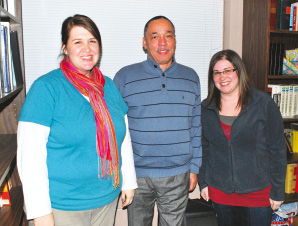
By Leslie Collins
Northeast News
December 21, 2011
For six weeks, three urban ministry students have tread the streets of Northeast, studying the urban core.
They chatted on resident’s porches, sat in on neighborhood association meetings and met with neighborhood leaders. It’s all part of their Practicum and Urban Systems class at the Nazarene Theological Seminary in Kansas City, where each one is earning a master’s degree in urban ministry.
The students, James Fuller, Tara Lindahl and Katie Early, soon learned about Northeast’s diversity and how Northeast residents take pride in the area they call “home.” It’s an area NTS Professor and Executive Director of Bresee Institute Dr. Fletcher Tink once called home himself. For four years, he lived near the corner of Illinois and 12th Street.
“For me to listen to these guys (talk about Northeast) is very exciting,” Tink said of his students. “It brings back a lot of memories.”
Students had to answer the overarching question, “What grace can be found in the Northeast neighborhood?” And “What is the church doing to address the assets and struggles of the Northeast neighborhood?”
Tink explained the reason for the assignment.
“The urban core has many churches and doesn’t see a significant change in the community,” Tink said. “My question is, Are the churches part of the pathology or are they part of the solution?’ I feel like we ought to be part of the solution, but I’m not sure we’re asking the right questions.”
For the assignment, the three students studied 15 systems in Northeast ranging from transportation to politics to the economic situation to education.
“There were just so many layers,” Lindahl said. “We had 15 systems and we could have easily written 10 pages on each of the systems and we could have easily interviewed 100-plus individuals.”
Asked what surprised them about the area both Lindahl and Early said, “the diversity.”
“The diversity was a surprise – not only culturally, but the economic diversity because you have Pendelton Heights with old, beautiful, massive homes and then you have the East Bottoms, which is a major contrast,” Early said.
One of the challenges of the project was getting that “insider view,” Early said. Without living in the area, the students had to depend on residents for the inside scoop, she said.
Some of the downfalls to Northeast included the level of education and economic system, the students concluded.
“‘Cities are the engines of economic life,'” Lindahl said. “When I think of that quote and picture the expectations we had in the neighborhood, it boggles my mind a little bit. If this really is the engine, what’s happening to the rest of the machine?”
Researching the poverty and unemployment rate, Lindahl said the largest demographic in Northeast is operating on an income of $15,000 per year per household, according to the Nazarene Research Center. That means a family of two would be living at or below the poverty line, according to 2009 poverty guidelines, Lindahl said.
“I imagine a lot of the families in the Northeast neighborhood have more than two people in their families. To me, that’s a startling statistic. There’s something wrong with the engine here,” she said.
More than 43 percent of Northeast residents are not in the labor force and 6.6 percent are unemployed, she said.
Another obstacle is education, Lindahl said. Nearly 33 percent of residents’ highest form of education is a high school diploma and 14 percent of residents are operating at a ninth grade level or lower, according to the Nazarene Research Center.
“That’s an incredibly sad statistic to me,” Lindahl said.
However, there are well covered services in Northeast, like access to a number of health care facilities and vast recreational and entertainment opportunities, the students said. Early said Northeast contains at least a dozen parks and includes the American Jazz Museum, Negro Leagues Baseball Museum, Kansas City Museum, a soccer league and other amenities.
“What I really gained was the interconnectedness of all the systems in a city,” Early said. “Just how education can affect economies and transportation can affect a person’s ability to get to work.”
“I learned the Northeast community is such a vibrant community, that life is ongoing,” Fuller said. “Even though they have their daily struggles, they still enjoy this community and enjoy living here… Each one of them (residents) that we talked to expressed their love for the community and they had no desire to leave here. Each one of them just said that this is their home.”
Lindahl agreed.
“The undeniable theme was they had a definite pride in their neighborhood,” she said.
After perusing the streets of Northeast, Lindahl is ready to come back to visit once the weather warms up. She’s ready to sample more of Northeast’s ethnic cuisine and unique shops, she said.
“Just the richness is really appealing,” Lindahl said. “I think it’s kind of like a secret that a lot of people aren’t aware of in Kansas City – just the richness that is here.”

















